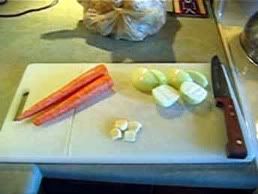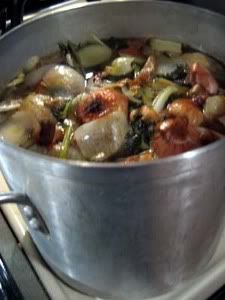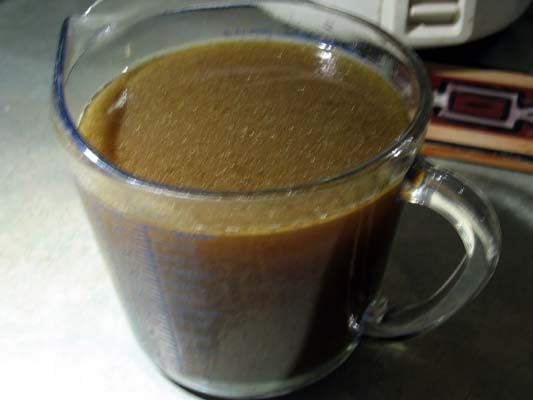Chicken Stock
I love the smell of stock simmering on the stovetop for hours. I love feeling like I've wrung every last use out of a whole chicken when I make chicken stock. First as a roasted chicken with gravy made from the giblets inside (though I'm giving up on the giblets due to the cholesterol). Then as leftovers to be recycled in other dishes. I'll stash the bones in the freezer along with vegetable scraps. And on the weekend, when enough has been gathered and I'll be home for several hours, I'll toss all of these collected scraps into the stock pot, throw in a few extra ingredients and then let it simmer away, filling the house with a smell that fools you into thinking that any minute now, a delicious dinner will be served.

Is it worth the extra time? The sauces, stews, and soups I've made with this homemade stock taste so much richer. Plus you can control the sodium levels of your broth which tends to be high in the already prepared ones. I usually make a big batch of chicken stock and then keep the extra stock in the freezer. Very flexible. The active time isn't really that much time. Mostly it's the cleanup at the end that's a pain.
Here's a list of some of the vegetable scraps I keep in the bag in the freezer:
carrots
garlic skins
parsley
herb stems
parsnips
turnips
squash peel
fennel
leeks
asparagus stems
celery (don't include the leaves; they're bitter)
mushroom stems
ginger
Some other recipes the stock has gone into:
Dijon Chicken Stew with Potatoes and Kale
Chicken Marsala a la Michael
Chicken Piccata
Shepherds Pie with Leftover Chicken
Chicken in a Cherry Sauce
Tortellini in Tomato Broth
Wonton Soup
Chicken Chow Foon
Eggplant Szechuan Style
Sweeties Scalloped Potatoes
Mafaldine con Funghi
Other references:
http://www.io.com/~sjohn/stock.htm
http://www.westonaprice.org/foodfeatures/broth.html
http://www.janegalt.net/blog/archives/005630.html
http://food.cookinglight.com/cooking/display/recipefinder.dyn?action=displayRecipe&recipe_id=224800 (requires subscription)
Thread at food_porn


Is it worth the extra time? The sauces, stews, and soups I've made with this homemade stock taste so much richer. Plus you can control the sodium levels of your broth which tends to be high in the already prepared ones. I usually make a big batch of chicken stock and then keep the extra stock in the freezer. Very flexible. The active time isn't really that much time. Mostly it's the cleanup at the end that's a pain.
Here's a list of some of the vegetable scraps I keep in the bag in the freezer:
carrots
garlic skins
parsley
herb stems
parsnips
turnips
squash peel
fennel
leeks
asparagus stems
celery (don't include the leaves; they're bitter)
mushroom stems
ginger
- Put all your frozen chicken bones and vegetable scraps into a stockpot (or the biggest pot you've got). I usually have the carcass from at least 1 whole chicken and often times a second chicken and a bunch of wing bones too.

- Add a few fresh ingredients. You don't need to peel these.
- 2 whole carrots snapped in half
- 2 stalks of celery snapped in half
- 2 cloves of garlic sliced in half, and
- 1 medium onion, sliced in quarters

- Add some salt (half a tsp?), whole peppercorns(about 10?), a bay leaf or two
- Fill pot with water to cover.

- Cover with the lid and bring water to a boil.
- Lower heat to a simmer. Keep checking on it every 10 minutes for the first half hour. Skim any scum that rises to the surface. I forget what the scum is but I think you're supposed to remove it and it looks gross anyhow.
- Continue simmering for 4-6 hours. I prefer to let it simmer for a longer time and reduce the volume of the stock but make it concentrated. Continue skimming scum if you see any whenever you check back to make sure there's still water in the pot. It will smell maddeningly good.
- Once done, remove from heat. I like to use a slotted spoon and tongs to remove all the big chunks from the stock. Discard all of those chunks and bones. Pour the stock through a sieve. And voila! You've got yourself some stock.

- I like to store this overnight in the fridge and then skim the congealed fat from the top the next day. I usually end up with about 4 quarts of stock. 3 quarts go into the freezer. And I keep one in our fridge. We use this stock in making sauces, soups, and stews. Depending on what we're using it for, we'll dilute the stock with some water. Enjoy!
Some other recipes the stock has gone into:
Dijon Chicken Stew with Potatoes and Kale
Chicken Marsala a la Michael
Chicken Piccata
Shepherds Pie with Leftover Chicken
Chicken in a Cherry Sauce
Tortellini in Tomato Broth
Wonton Soup
Chicken Chow Foon
Eggplant Szechuan Style
Sweeties Scalloped Potatoes
Mafaldine con Funghi
Other references:
http://www.io.com/~sjohn/stock.htm
http://www.westonaprice.org/foodfeatures/broth.html
http://www.janegalt.net/blog/archives/005630.html
http://food.cookinglight.com/cooking/display/recipefinder.dyn?action=displayRecipe&recipe_id=224800 (requires subscription)
Thread at food_porn